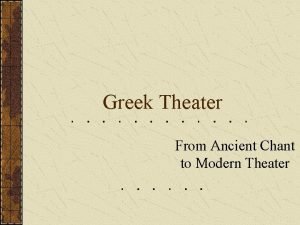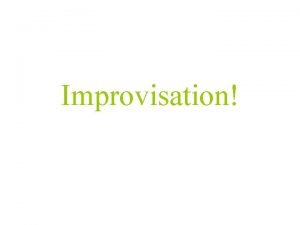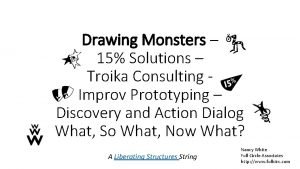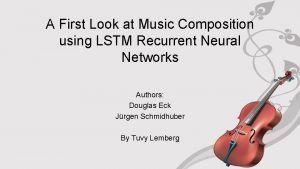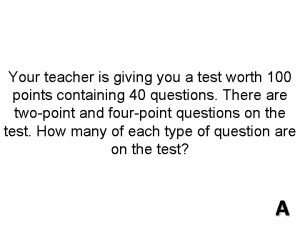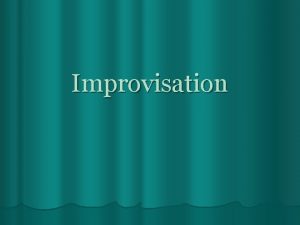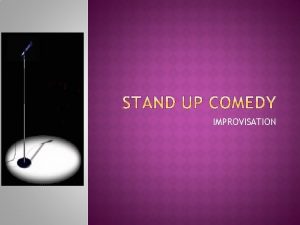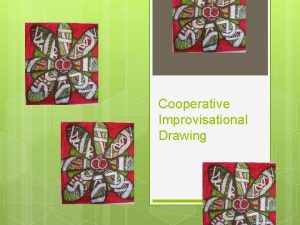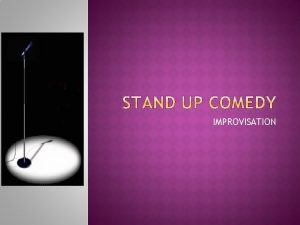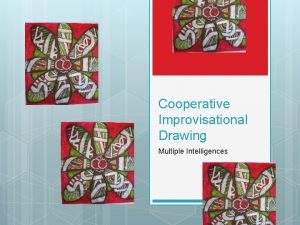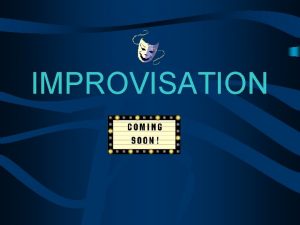Improvisation improv Improvisational Theater improv is a form









- Slides: 9

Improvisation (improv)

• Improvisational Theater (improv): is a form of theater where most or all of what is performed is created at the moment it is performed. • In its purest form, the dialogue, the action, the story and the characters are created collaboratively by the players as the improvisation unfolds. • Improv exists in performance as a range of styles of improvisational comedy as well as some non-comedic theatrical performances. • It is sometimes used in film and television, both to develop characters and scripts and occasionally as part of the final product.

• The skills and processes of improvisation are used outside of performance as well. It is often used extensively in drama programs to train actors for stage, film and television and can be an important part of the rehearsal process. • It is used in classrooms and businesses as an educational tool and as a way to develop communication and brain-storming skills. • It is sometimes used in psychotherapy as a tool to gain insight into a person's thoughts, feelings and relationships.

Improvisational comedy • Modern improvisational comedy, as it is practiced in the West, falls generally into two categories: shortform and longform. • Shortform improv consists of short scenes usually constructed from a predetermined game, structure, or idea and driven by an audience suggestion. Many shortform games were first created by Viola Spolin based on her training from Neva Boyd. • The shortform improv comedy television series Whose Line Is It Anyway? has familiarized viewers with shortform.

• Longform improv performers create shows in which short scenes are often interrelated by story, characters, or themes. • Longform shows may take the form of an existing type of theatre, for example a full-length play or Broadway-style musical such as Spontaneous Broadway. • One of the better-known longform structures is the Harold, developed by Improv. Olympic co-founder Del Close. • Many such longform structures now exist. In the UK the Comedy Store Players are a well known shortform improv group, who are also in the Guinness World Records.

Non-comedic improv • Other forms of improvisational theatre training and performance techniques are experimental and Avant-garde in nature and not necessarily intended to be comedic. • These include Playback Theatre and Theatre of the Oppressed, the Poor Theatre, the Open Theatre, to name only a few.

KEY TERMS • Improvisation (improv): the impromptu portrayal of a character or scene without any rehearsal or preparation. • Spontaneity: – the quality or state of being spontaneous – the spontaneity of their behavior – the couple sacrificed some of the spontaneity in their lives when they had a baby – voluntary or undetermined action or movement; : its source • “illusion of the first time”: a situation in which an audience is led to believe that each performance is the first.

• Scene stealing: calling attention to one’s presence onstage and diverting attention away from the main actors. • Character-centered approach: an approach to telling a story that focuses on a character or a group of characters who experience different situations. • Situation-centered approach: an approach to telling a story that takes a single situation or a series of situations and puts characters in them to show different personalities respond to the same event.

• Motivated sequence: the natural way in which a person responds to a stimulus – the brain registers, the body responds and then reacts – as mirrored by an actor in an improvisation.
 A form of vocal improvisation on nonsense syllables.
A form of vocal improvisation on nonsense syllables. Greek theater vs modern theater
Greek theater vs modern theater What is improvisation
What is improvisation Improv prototyping
Improv prototyping Improvisation tips
Improvisation tips Jazz improvisation with lstm
Jazz improvisation with lstm Elements of improvisation
Elements of improvisation Improvisation 28 kandinsky
Improvisation 28 kandinsky Affirmative form negative form interrogative form
Affirmative form negative form interrogative form Gabby and sydney bought some pens
Gabby and sydney bought some pens

